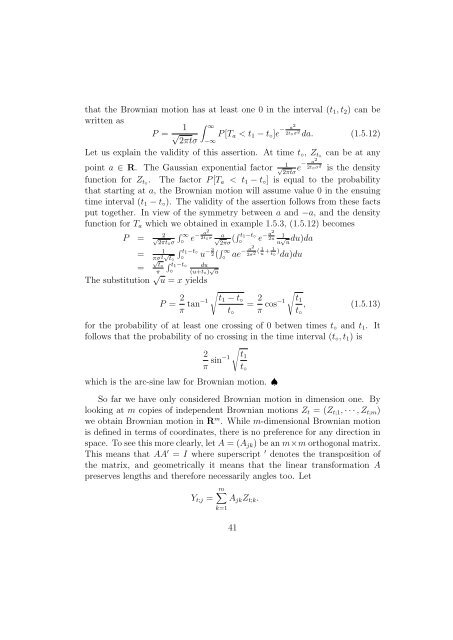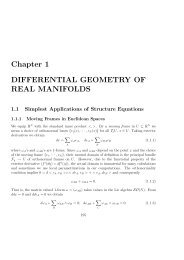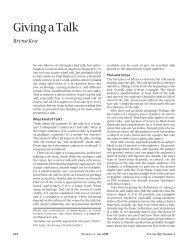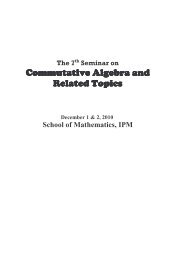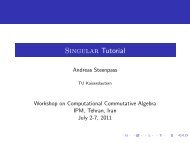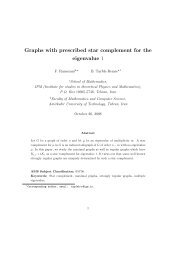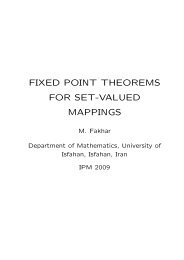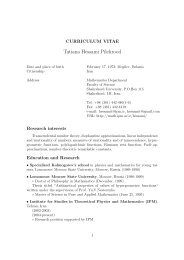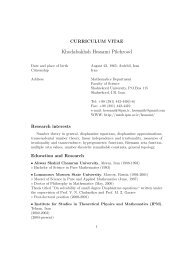1 Continuous Time Processes - IPM
1 Continuous Time Processes - IPM
1 Continuous Time Processes - IPM
Create successful ePaper yourself
Turn your PDF publications into a flip-book with our unique Google optimized e-Paper software.
that the Brownian motion has at least one 0 in the interval (t1, t2) can be<br />
written as<br />
P =<br />
<br />
1 ∞<br />
a2<br />
−<br />
√ P [Ta < t1 − t◦]e 2t◦σ<br />
2πtσ −∞<br />
2 da. (1.5.12)<br />
Let us explain the validity of this assertion. At time t◦, Zt◦ can be at any<br />
a2<br />
1 −<br />
point a ∈ R. The Gaussian exponential factor √ e 2t◦σ<br />
2πtσ 2 is the density<br />
function for Zt◦. The factor P [Ta < t1 − t◦] is equal to the probability<br />
that starting at a, the Brownian motion will assume value 0 in the ensuing<br />
time interval (t1 − t◦). The validity of the assertion follows from these facts<br />
put together. In view of the symmetry between a and −a, and the density<br />
function for Ta which we obtained in example 1.5.3, (1.5.12) becomes<br />
∞<br />
a2<br />
2 P = √<br />
2πt◦σ ◦ e− 2t◦σ √2πσ a ( t1−t◦<br />
a2<br />
− 1<br />
◦ e 2u<br />
u √ udu)da 1 = πσ2√ t1−t◦<br />
3<br />
−<br />
t◦ ◦ u 2 ( a2 1 1<br />
∞<br />
◦ ae− 2σ2 ( + u t◦ ) da)du<br />
= √ t◦ t1−t◦ du<br />
π ◦ (u+t◦) √ u<br />
The substitution √ u = x yields<br />
P = 2<br />
π tan−1<br />
<br />
t1 − t◦<br />
t◦<br />
= 2<br />
π cos−1<br />
<br />
t1<br />
t◦<br />
, (1.5.13)<br />
for the probability of at least one crossing of 0 betwen times t◦ and t1. It<br />
follows that the probability of no crossing in the time interval (t◦, t1) is<br />
2<br />
π sin−1<br />
<br />
t1<br />
which is the arc-sine law for Brownian motion. ♠<br />
So far we have only considered Brownian motion in dimension one. By<br />
looking at m copies of independent Brownian motions Zt = (Zt;1, · · · , Zt;m)<br />
we obtain Brownian motion in R m . While m-dimensional Brownian motion<br />
is defined in terms of coordinates, there is no preference for any direction in<br />
space. To see this more clearly, let A = (Ajk) be an m×m orthogonal matrix.<br />
This means that AA ′ = I where superscript ′ denotes the transposition of<br />
the matrix, and geometrically it means that the linear transformation A<br />
preserves lengths and therefore necessarily angles too. Let<br />
Yt;j =<br />
t◦<br />
m<br />
AjkZt;k.<br />
k=1<br />
41


